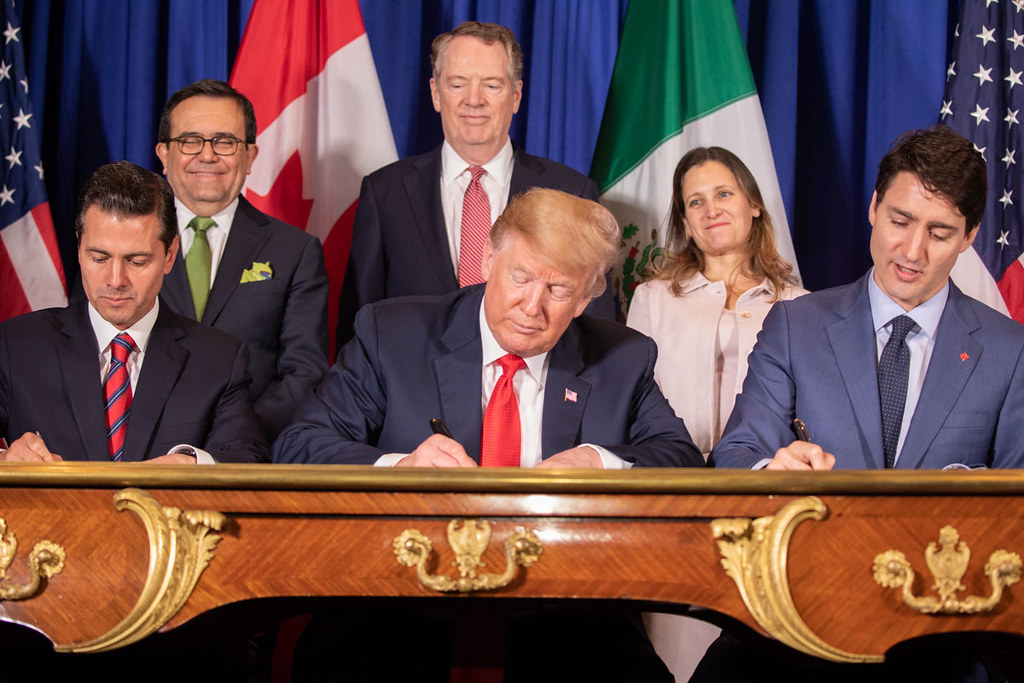The Canada-United States-Mexico Agreement (CUSMA) is a free trade agreement between Canada, the United States and Mexico. It is a revised and renamed version of the North American Free Trade Agreement (NAFTA). The leaders of the three countries signed CUSMA in November 2018 after 13 months of intense negotiations that concluded in September. Canada was the last country to pass enabling legislation, which received royal assent on 13 March 2020. The agreement came into effect on 1 July 2020.
CUSMA is expected to have only a modest impact on economic growth. However, it could have a major impact on the restructuring of the North American economy. It may also limit Canada’s policy options in moving to a new economy based on knowledge, data and intellectual property.

Negotiation
In 2016, while campaigning for the US presidency, Donald Trump described NAFTA as “the worst trade deal ever made.” He promised to scrap it unless Canada and Mexico agreed to changes favouring the United States. Both countries depended heavily on the US market for exports of goods and services. Therefore, they felt they had to negotiate. But they, too, had changes they wished to make.
For almost a year during negotiations, the United States imposed high tariffs on imports of Canadian steel and aluminum. It justified these tariffs by branding Canadian exports a national security threat. Canada retaliated with similar tariffs. The United States also sought leverage by threatening additional tariffs on Canadian autos and auto parts. Liberal cabinet minister Chrystia Freeland represented Canada in the negotiations.

Provisions
CUSMA retained much of the original NAFTA and modernized other parts of the agreement. CUSMA also added new provisions, largely to meet new US demands. For the first time, it includes chapters on labour, the environment, small and medium-size businesses, and digital trade.
The new agreement brings about three key changes. First, it tightens access to preferential tariff treatment in key industries such as autos. Second, it introduces new elements of managed trade, such as in the agriculture and auto sectors. Third, it imposes potential new constraints on future domestic policy initiatives in some key areas. These potential constraints mainly target the digital and intangibles economy where intellectual property and data are key sources of value.
The sections below highlight some of the most notable changes by sector or issue.
Automotive
One of the most important changes for Canada came from new rules of origin for automobiles and parts. These rules increased the percentage of North American content that vehicles must contain to avoid duties at the border. The goal was to discourage vehicle and parts production in low-cost environments, including Mexico, and attract more automotive investment to the United States. Canada hoped to benefit from increased investment due to the new rules as well. However, the new rules of origin may make automobiles more expensive for consumers. They may also make the industry less competitive.
Agriculture and Dairy
The critical issue for Canada was the future of its supply management system for dairy, eggs and poultry. The elimination of this system was a key US target. Canada was forced to make concessions in CUSMA to maintain supply management.
Under CUSMA, American dairy, egg and poultry producers will gain further market access in Canada. This access will be phased in over six years with further growth after that. In addition, Canada agreed to involve the United States in any planned changes to Canada’s dairy policies. And in a new step in a trade agreement, Canada agreed to reduce and control exports of specified dairy products to any country in the world. This means that Canada will impose a hefty tax on any exports that exceed the agreed-to limits. (See also Agriculture and Food Policy.)
Environment
In an advance from NAFTA, CUSMA contains a specific chapter on the environment. The chapter contains a commitment from each country to end subsidies that encourage overfishing. It largely leaves each country free, however, to make its own environmental laws and standards. This means that a member country can even lower its environmental standards unless it has clearly done so to create an economic advantage in trade or investment between the parties.
The chapter makes no mention of climate change or measures to reduce greenhouse gas emissions. Such measures had been a Canadian goal. The chapter states that each country should have procedures to protect the environment. On this point, however, it omits any specific or binding actions.
Labour
The new chapter on labour in CUSMA mainly aims to bring Mexico’s labour standards closer to those of Canada and the United States. It focuses on the right to organize labour unions and engage in collective bargaining.
Data and Privacy
A new chapter on digital trade contains policies affecting data ownership, privacy and localization laws. (Localization laws require certain types of data to be stored on computers located in Canada.) The digital trade chapter helps entrench the role of US platform companies (e.g., Google and Facebook) in Canada. It also limits Canada’s future ability to make changes in several areas. Canada may have less power to protect personal data or to devise its own policies for the future digital economy. It may also have less power to access source codes or algorithms used by US companies operating in Canada.

Critics contend that this was the wrong time for Canada to give up its policy flexibility in a trade agreement. Digitization will play such a major role in the future, yet we know little about the shapes it will take. For example, much of our future infrastructure — including electric power grids, utilities, traffic management and autonomous vehicle systems, the online flow of money, smart cities and smart homes — will rely on artificial intelligence, 5G networks and the Internet of Things. Each of these technologies has important implications for the ownership and use of data. (See also Computers and Canadian Society.)
Under this chapter, each country is to have a privacy policy that protects personal information by law. The three countries also agree to cooperate on cybersecurity and other issues in digitization.
Intellectual Property
New rules on intellectual property extend copyright protection on works such as books, music and films. Where copyright previously covered the life of the creator plus 50 years, it now spans life plus 70 years. The new rules also require stronger action against shipments of counterfeit goods at the border. Moreover, they require member countries to impose criminal penalties for theft of trade secrets.
Culture
CUSMA continues the NAFTA exemptions for Canadian cultural industries. Cultural industries include publishers of printed or recorded media as well as broadcasters. The exemptions allow for measures like Canadian content rules, subsidies and taxes to support Canadian cultural industries. However, CUSMA allows the United States or Mexico to retaliate in the event of a new Canadian measure with “a measure of equivalent commercial effect.” Such a measure could be a tariff or other restriction on a Canadian industry. With the new chapter regulating digital trade, the scope for this retaliation is potentially much broader under CUSMA than it was under NAFTA. A number of digital cultural activities (e.g., Netflix productions) were not covered under the previous agreement, so measures of equivalent commercial effect could not be applied.
Indigenous Rights
CUSMA states that nothing in the agreement prevents a party from “adopting or maintaining a measure…to fulfill its legal obligations to indigenous peoples.” Canada had a socially progressive trade agenda in negotiations. It aimed to attach social conditions to CUSMA, including Indigenous rights and gender issues. Yet the realities in the three North American countries are so different that such conditions would likely have been impossible to negotiate in a trade agreement.
Other Provisions
The agreement contains many more provisions that cover a range of issues. These provisions include economic integration between the countries, the duration of the agreement, and procedures for managing CUSMA and settling disputes.
Dispute settlement was a make-or-break issue for Canada. The United States wanted to end any provision for resolving disputes. But Canada needed some legal assurance that the United States would abide by the agreement. Canada was able to retain and even strengthen the dispute settlement system. The United States also wanted to put a five-year limit on the agreement. The final term negotiated was a 16-year life with provision for ongoing extension.
Impact and Criticism
Overall, experts predict that CUSMA will have only a modest impact on Canada’s economy. Global Affairs Canada projected that Canada would be better off under CUSMA by just 0.249 per cent of GDP by 2025 compared to a scenario in which NAFTA lapsed. The C.D. Howe Institute projected a decline of 0.4 per cent of GDP by 2025 compared to the current status quo of an in-force NAFTA.
These assessments left many important questions unanswered. They did not examine how the new rules would affect Canada’s ability to pursue new economic and trade policies (e.g., on intellectual property and data). Nor did they examine CUSMA’s potential impact on future business investment in Canada in any depth. What the agreement might mean for Canada’s freedom to negotiate future trade deals is also uncertain. The United States insisted on a provision that would complicate a trade agreement between Canada and China. Canadian trade analysts widely criticized this as a move to discourage Canada from pursuing new trade deals with China.
Key Terms
Subsidy — Money that governments give to companies or organizations to help them keep the prices of their goods competitive, avoid laying off workers or provide a service that is in the public interest.
Tariff — A tax on imported goods and services, aimed at making these products more expensive.

 Share on Facebook
Share on Facebook Share on X
Share on X Share by Email
Share by Email Share on Google Classroom
Share on Google Classroom











_IMO_9785756,_Maasmond_pic.jpg)


